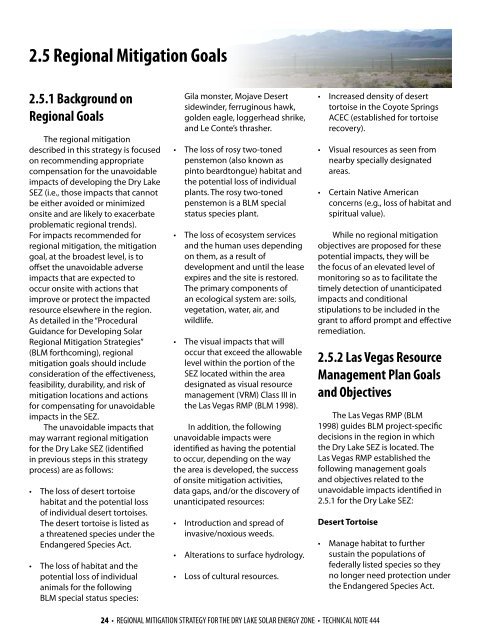xs7hy9e06w?redirect_to=http://www.blm.gov/pgdata/etc/medialib/blm/wo/blm_library/tech_notes.Par.29872.File.dat/TN_444
xs7hy9e06w?redirect_to=http://www.blm.gov/pgdata/etc/medialib/blm/wo/blm_library/tech_notes.Par.29872.File.dat/TN_444
xs7hy9e06w?redirect_to=http://www.blm.gov/pgdata/etc/medialib/blm/wo/blm_library/tech_notes.Par.29872.File.dat/TN_444
Create successful ePaper yourself
Turn your PDF publications into a flip-book with our unique Google optimized e-Paper software.
2.5 Regional Mitigation Goals<br />
2.5.1 Background on<br />
Regional Goals<br />
The regional mitigation<br />
described in this strategy is focused<br />
on recommending appropriate<br />
compensation for the unavoidable<br />
impacts of developing the Dry Lake<br />
SEZ (i.e., those impacts that cannot<br />
be either avoided or minimized<br />
onsite and are likely to exacerbate<br />
problematic regional trends).<br />
For impacts recommended for<br />
regional mitigation, the mitigation<br />
goal, at the broadest level, is to<br />
offset the unavoidable adverse<br />
impacts that are expected to<br />
occur onsite with actions that<br />
improve or protect the impacted<br />
resource elsewhere in the region.<br />
As detailed in the “Procedural<br />
Guidance for Developing Solar<br />
Regional Mitigation Strategies”<br />
(BLM forthcoming), regional<br />
mitigation goals should include<br />
consideration of the effectiveness,<br />
feasibility, durability, and risk of<br />
mitigation locations and actions<br />
for compensating for unavoidable<br />
impacts in the SEZ.<br />
The unavoidable impacts that<br />
may warrant regional mitigation<br />
for the Dry Lake SEZ (identified<br />
in previous steps in this strategy<br />
process) are as follows:<br />
• The loss of desert tortoise<br />
habitat and the potential loss<br />
of individual desert tortoises.<br />
The desert tortoise is listed as<br />
a threatened species under the<br />
Endangered Species Act.<br />
• The loss of habitat and the<br />
potential loss of individual<br />
animals for the following<br />
BLM special status species:<br />
Gila monster, Mojave Desert<br />
sidewinder, ferruginous hawk,<br />
golden eagle, loggerhead shrike,<br />
and Le Conte’s thrasher.<br />
• The loss of rosy t<strong>wo</strong>-toned<br />
penstemon (also known as<br />
pinto beardtongue) habitat and<br />
the potential loss of individual<br />
plants. The rosy t<strong>wo</strong>-toned<br />
penstemon is a BLM special<br />
status species plant.<br />
• The loss of ecosystem services<br />
and the human uses depending<br />
on them, as a result of<br />
development and until the lease<br />
expires and the site is restored.<br />
The primary components of<br />
an ecological system are: soils,<br />
vegetation, water, air, and<br />
wildlife.<br />
• The visual impacts that will<br />
occur that exceed the allowable<br />
level within the portion of the<br />
SEZ located within the area<br />
designated as visual resource<br />
management (VRM) Class III in<br />
the Las Vegas RMP (BLM 1998).<br />
In addition, the following<br />
unavoidable impacts were<br />
identified as having the potential<br />
to occur, depending on the way<br />
the area is developed, the success<br />
of onsite mitigation activities,<br />
<strong>dat</strong>a gaps, and/or the discovery of<br />
unanticipated resources:<br />
• Introduction and spread of<br />
invasive/noxious weeds.<br />
• Alterations to surface hydrology.<br />
• Loss of cultural resources.<br />
• Increased density of desert<br />
tortoise in the Coyote Springs<br />
ACEC (established for tortoise<br />
recovery).<br />
• Visual resources as seen from<br />
nearby specially designated<br />
areas.<br />
• Certain Native American<br />
concerns (e.g., loss of habitat and<br />
spiritual value).<br />
While no regional mitigation<br />
objectives are proposed for these<br />
potential impacts, they will be<br />
the focus of an elevated level of<br />
monitoring so as to facilitate the<br />
timely detection of unanticipated<br />
impacts and conditional<br />
stipulations to be included in the<br />
grant to afford prompt and effective<br />
remediation.<br />
2.5.2 Las Vegas Resource<br />
Management Plan Goals<br />
and Objectives<br />
The Las Vegas RMP (BLM<br />
1998) guides BLM project-specific<br />
decisions in the region in which<br />
the Dry Lake SEZ is located. The<br />
Las Vegas RMP established the<br />
following management goals<br />
and objectives related to the<br />
unavoidable impacts identified in<br />
2.5.1 for the Dry Lake SEZ:<br />
Desert Tortoise<br />
• Manage habitat to further<br />
sustain the populations of<br />
federally listed species so they<br />
no longer need protection under<br />
the Endangered Species Act.<br />
24 • REGIONAL MITIGATION STRATEGY FOR THE DRY LAKE SOLAR ENERGY ZONE • TECHNICAL NOTE <strong>444</strong>


